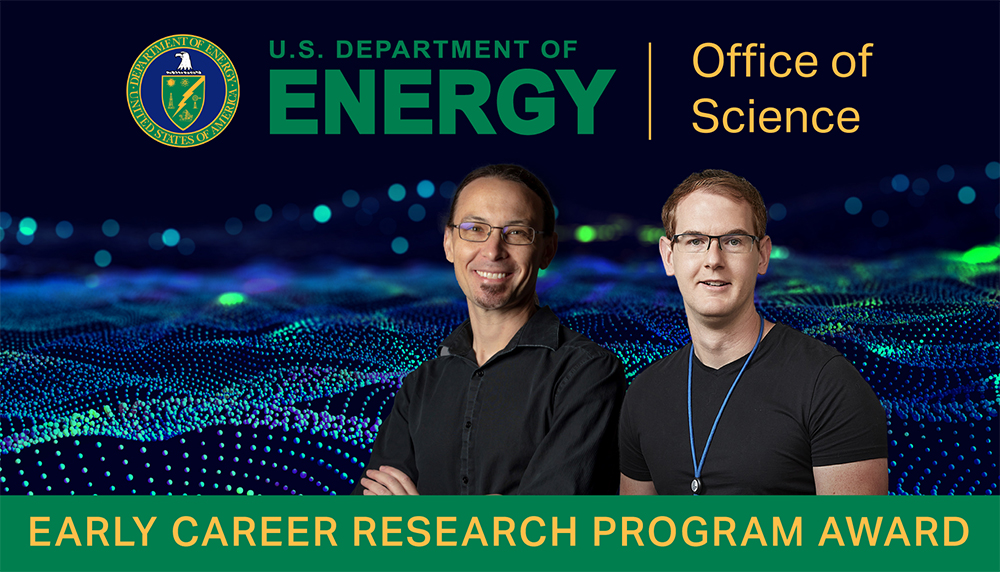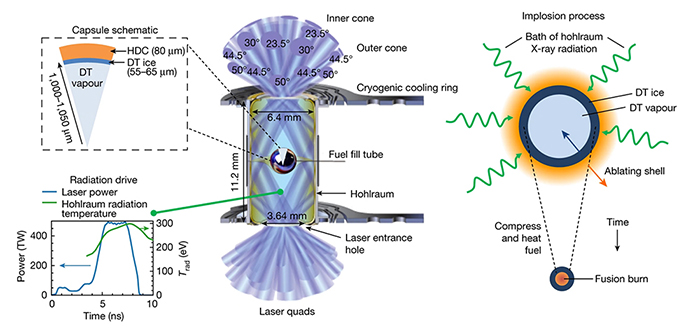Daniel Casey Receives DOE
Early Career Research Program Award
August 11, 2023
NIF & Photon Science physicist Daniel Casey, who has made important contributions to LLNL’s success in achieving ignition on NIF, has received the Department of Energy (DOE) Office of Science Early Career Research Program award for his work in fusion energy sciences.
Casey and LLNL chemist Gauthier Deblonde are among 93 awardees receiving the recognition. Under the program, typical awards for DOE national laboratory staff are $500,000 per year for five years.
 Daniel Casey (left) and Gauthier Deblonde are recipients of the Department of Energy’s Office of Science Early Career Research Program award.
Daniel Casey (left) and Gauthier Deblonde are recipients of the Department of Energy’s Office of Science Early Career Research Program award. “Supporting America’s scientists and researchers early in their careers will ensure the United States remains at the forefront of scientific discovery,” said U.S. Energy Secretary Jennifer M. Granholm. “The funding announced today gives the recipients the resources to find the answers to some of the most complex questions as they establish themselves as experts in their fields.”
The Early Career Research Program, now in its 14th year, is designed to bolster the nation’s scientific workforce by providing support to exceptional researchers during crucial early-career years, when many scientists do their most formative work.
Casey serves as the low-mode working group lead for LLNL’s Inertial Confinement Fusion (ICF) Program. His work focuses on diagnosing and assessing the impact of asymmetries, a key factor in the performance of ICF implosions.
“I am so honored and humbled to be recognized for the DOE Early Career award by the DOE Office of Science/Fusion Energy Sciences,” he said. “I have been so fortunate to work with so many great and talented colleagues at LLNL over the years. That we have been selected for this award is a recognition of how our many capabilities can contribute to the growing promise of fusion energy.
“It’s really a reflection of the importance and the impact of the work that we do here at NIF and LLNL to be selected for this funding award,” he added. “I am particularly excited because this award also is a recognition of the potential impact our research can have on inertial fusion energy (IFE).”
In ICF implosions, a key element of the National Nuclear Security Administration’s science-based Stockpile Stewardship Program, NIF’s 192 lasers tightly focus on a tiny fuel capsule suspended inside a cylindrical x-ray oven called a hohlraum. The heat from the x rays blow off, or ablate, the surface of the target capsule containing deuterium and tritium (DT) fuel. The capsule surface implodes, compressing and heating the fuel until the hydrogen atoms fuse, releasing neutrons and other forms of energy (see “How NIF Works”).
 This graphic shows a typical NIF indirect-drive target configuration. In the center graphic, laser beams (blue) enter the hohlraum through laser entrance holes at various angles. At top left, a schematic pie diagram shows the radial distribution and dimensions of materials in diamond (high-density carbon or HDC) ablator implosions. At bottom left, the temporal laser power pulse-shape (blue) and associated hohlraum radiation temperature (green) are shown. At right, at the center of the hohlraum, the capsule is bathed in x-rays, which ablate the outer surface of the capsule. The pressure generated implodes the capsule, compressing and heating the DT fuel.
This graphic shows a typical NIF indirect-drive target configuration. In the center graphic, laser beams (blue) enter the hohlraum through laser entrance holes at various angles. At top left, a schematic pie diagram shows the radial distribution and dimensions of materials in diamond (high-density carbon or HDC) ablator implosions. At bottom left, the temporal laser power pulse-shape (blue) and associated hohlraum radiation temperature (green) are shown. At right, at the center of the hohlraum, the capsule is bathed in x-rays, which ablate the outer surface of the capsule. The pressure generated implodes the capsule, compressing and heating the DT fuel. Casey compared the implosion process to crushing a balloon in your hands to the size of a pea. The build-up of pressure will stress the balloon at any weak spots until it finally breaks. Small imperfections in ICF targets—like non-uniformities in target capsule shell thickness of less than 1 percent—can cause 3D asymmetries that rob energy from the capsule’s central hot spot.
“Never mind the large gaps between fingers crushing a balloon,” he said. “If an implosion has an asymmetry (one half thicker than the other half) by about the height of a typical bump on a basketball relative to its diameter, that’s enough to prevent ignition in an ICF implosion. Our job is to diagnose these problems when they happen so we can prevent them from reoccurring.”
Casey also leads experimental efforts to increase implosion compression as a potential pathway to higher energy gains on NIF. He said the award funding could help enable the team to assess some important questions facing IFE systems, particularly with respect to the impact of asymmetries and the mixing of target capsule material with fusion fuel.
Studying Radioactive Elements
Deblonde was selected for his work in basic energy sciences. As a staff scientist in the Nuclear and Chemical Sciences Division and the Physical and Life Sciences Directorate, Deblonde’s work focuses on developing new techniques to decipher the chemistry of radioactive elements.
“I’m elated and honored to join the small group of scientists who have been awarded a DOE Early Career award,” he said. “This is extremely competitive because applicants are national laboratory scientists and university professors from many disciplines (physics, chemistry, biology, computing, etc.) and, in the 14 years of existence of the award, I am the first LLNL employee to get it in the category ‘Basic Energy Sciences,’ so the news felt even better.
“It is not just my success but also that of the colleagues and collaborators who helped me build a consistent and competitive research portfolio.”
Deblonde, who joined LLNL as a postdoc in 2019 and converted to a staff scientist a year later, has always been fascinated by “difficult-to-study” materials. So he naturally turned to nuclear sciences, and particularly the chemistry of heavy elements and actinides, a family of 15 radioactive elements that includes uranium and plutonium.
Most of these elements exist only in trace amounts in nature or need to be produced in nuclear reactors and as a result, very little is known about their chemical properties. Deblonde’s research focuses on developing new strategies to probe the chemistry of these rare, toxic, and elusive elements.
“Applications of this kind of research can be far-reaching and span from cancer treatments to nuclear waste management, forensics, nuclear imaging, the fundamental understanding of the periodic table, and more,” Deblonde said.
He said the award funding will provide a significant boost to heavy element chemistry research at LLNL.
“The research activities related to this award will build on prior in-house investments and breakthroughs we made in the past four years and I am confident we will be able to decode the chemistry (structural, electronic, magnetic, and vibrational properties) of rare, radioactive and toxic elements that have so far remained inaccessible with current laboratory techniques,” he said. “I am really hoping to push the limits of what we know about actinides and heavy elements in general. This research program also will serve as a platform to host student interns and mentor them to be the next generation of radiochemists.”
Since its inception in 2010, the Early Career Research Program has made 868 awards, with 564 awards to university researchers and 304 awards to national lab researchers.
To be eligible for the DOE award, a researcher must be an untenured, tenure-track assistant or associate professor at a U.S. academic institution or a full-time employee at a DOE national laboratory who received a Ph.D. within the past 10 years. Research topics are required to fall within one of the Department’s Office of Science’s eight major program offices:
- Accelerator R&D and Production
- Advanced Scientific Computing Research
- Basic Energy Sciences
- Biological and Environmental Research
- Fusion Energy Sciences
- High Energy Physics
- Nuclear Physics
Awardees were selected from a large pool of university- and national laboratory-based applicants. The selection was based on peer review by outside scientific experts.
More Information:
“Study reveals cause of 3D asymmetry in ICF implosions,” LLNL News Release, February 25, 2021.
—Anne M. Stark
Follow us on Twitter: @lasers_llnl



